Click Here To Join Our Telegram Channel for FREE daily tutorials!
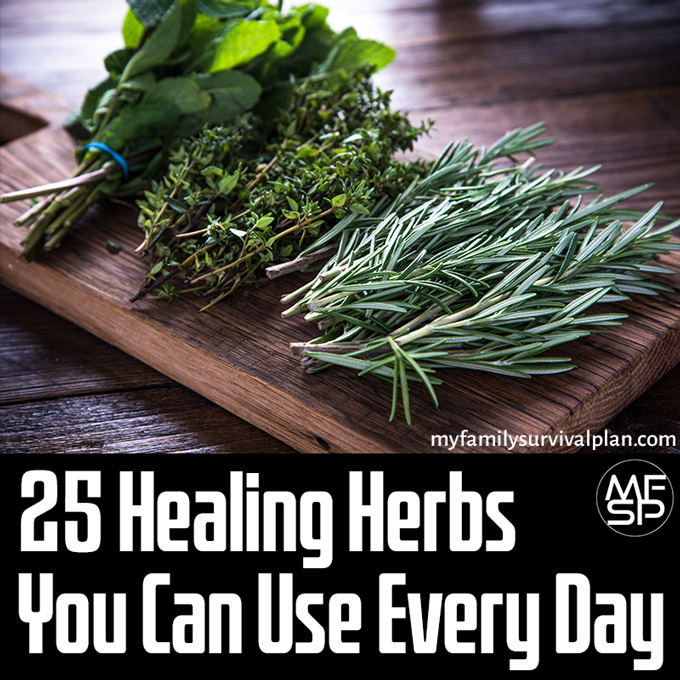
Graphic – www.myfamilysurvivalplan.com
Image – Shutterstock
Prepare your own home remedies for whatever ails you…
Nature’s medicine
There are times when it might be smarter to use an herbal remedy than a pharmaceutical. For example, sometimes an herb offers a safer alternative. Take chamomile: The flowers have been used for centuries as a gentle calmative for young and old alike. It’s non-habit-forming and well tolerated, and a study sponsored by the University of Michigan found that chamomile extract had roughly the same efficacy as many prescription sleeping medications when given to adults with insomnia. Likewise, peppermint oil has been shown to be as effective as pharmaceutical drugs for relieving irritable bowel syndrome, but without the ofttimes dangerous side effects. And clinical studies have shown that ginger relieves morning sickness, sage can relieve a sore throat, and hibiscus tea gently lowers blood pressure.
I believe it’s better to use mild remedies for minor health problems and save the more potent—and risky—prescription medications for more serious conditions. Here then, are my top 25 favorite healing herbs and their uses.
Safety notes – 1) be sure to discuss any herbs you are taking with your doctor. Some herbal remedies (such as the antidepressant St. John’s wort) can interact with medications. 2) do not collect wild plants unless you are absolutely 100% sure that you can identify them correctly. This applies particularly to berries and fungi but all plants require correct identification.
Ashwagandha (Withania somnifera)
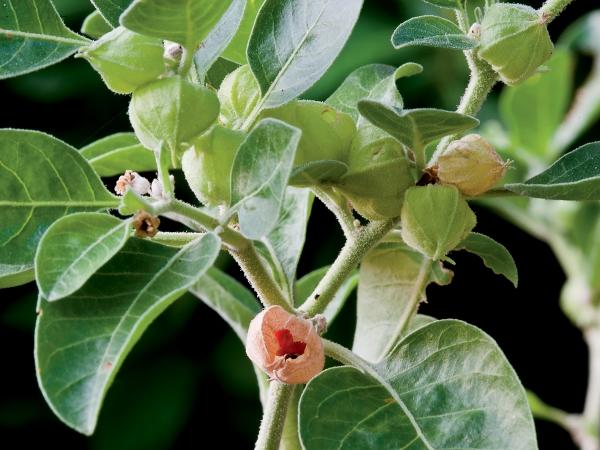
Uses:
Rejuvenating tonic, anti-inflammatory, reduces anxiety, boosts immune health
Preparation and doses:
Tea: Simmer 1 tsp dried and sliced root in 1 cup water or milk for 10 minutes. Strain. Drink 1 or 2 times per day.
Standardized Extract (2–5% withanolides): Take 500 mg 2 or 3 times per day.
Concerns:
Can cause milk sedation; potential to stimulate thyroid hormones
Black Cohosh (Actaea racemosa)
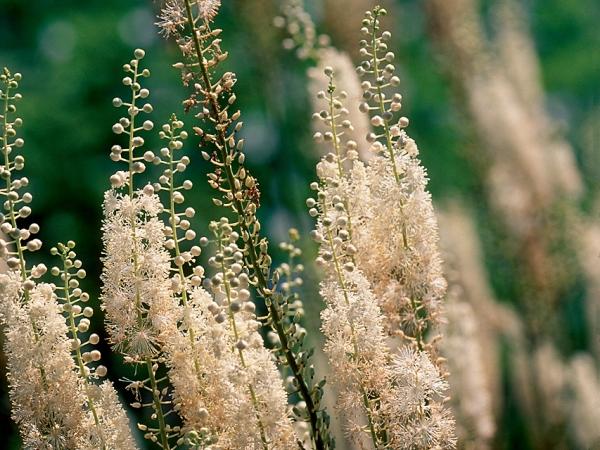
Uses:
Relieves menstrual cramps and arthritic pain; commonly used to ease menopausal symptoms
Preparation and doses:
Tincture: Take 1–2 ml 3 times per day.
Standardized extract: Take 20–80 mg 2 times per day.
Concerns:
Very rare case reports of liver damage (likely due to misidentified herb); purchase only from a reputable supplier
Calendula (Calendula officinalis)

Uses:
Calendula has long been used to relieve inflammation of the mouth, throat, and stomach; popular as a topical cream or ointment to relieve rashes and irritation and to help heal wounds.
Preparation and doses:
Tea: Pour 1 cup boiling water over 2 tsp petals. Steep for 10 minutes. Strain. Use as needed as a mouthwash, gargle, or tea.
Ointment: Apply to skin 2 or 3 times per day as needed.
Concerns:
None known
Catnip (Nepeta cataria)
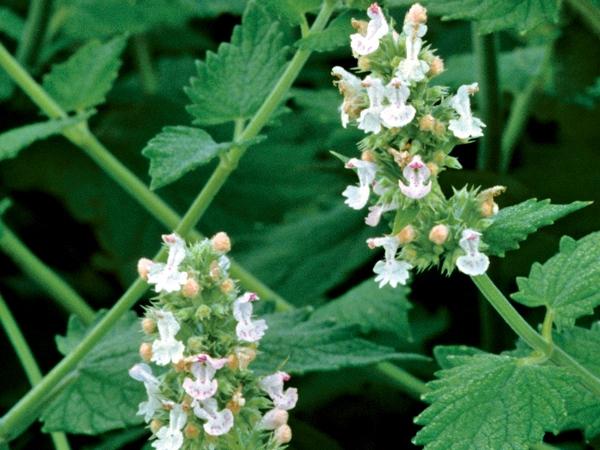
Uses:
Soothes an upset stomach; reduced anxiety and tension
Preparation and doses:
Tea: Pour 1 cup boiling water over 4 or 5 fresh or 1 tsp dried leaves. Steep for 5 minutes. Strain and sweeten, if desired. Drink 1 or 2 times per day.
Concerns:
None known
Chasteberry (Vitex agnus-castus)
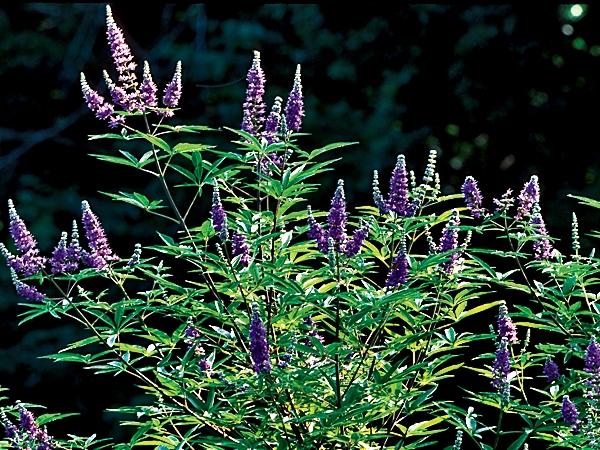
Uses:
Premiere herb for relieving PMS symptoms
Preparation and doses:
Capsules: Take 250–500 mg dried fruit once per day.
Tincture: Take 2–3 ml each morning.
Concerns:
None known
Cranberry (Vaccinium macrocarpon)
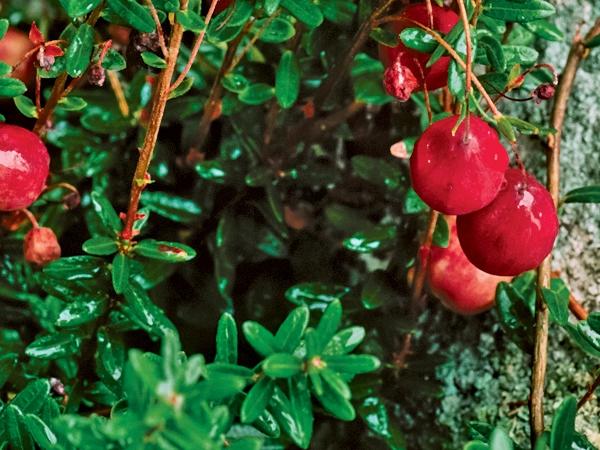
Uses:
Well-established treatment for reducing the risk of bladder infection; could also be beneficial for chronic prostatitis
Preparation and doses:
Juice: Drink ½-¾ cup twice per day.
Capsules: Take 300–500 mg concentrated juice extract 2 times per day.
Concerns:
None known
Echinacea (Echinacea spp.)
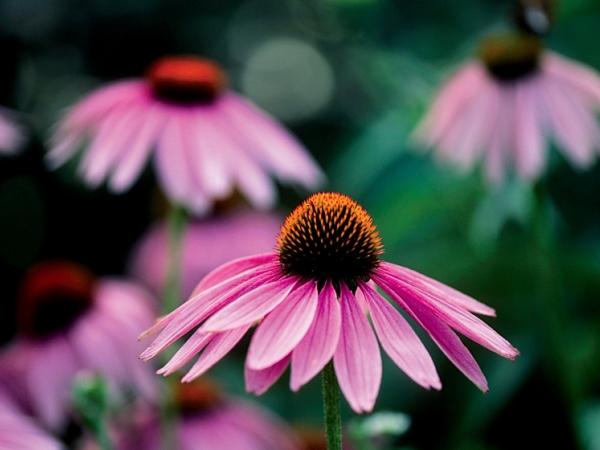
Uses:
Antiviral and immune-enhancing properties; popular for relieving colds and upper respiratory infections (approved in Europe for these uses)
Preparation and doses:
Tea: Simmer 1 tsp dried and sliced root in 1 cup water for 10 minutes. Strain. Drink 1-3 cups per day.
Tincture: Take 5 ml 3-6 times per day at the onset of cold symptoms.
Concerns:
Rare allergic reactions. Should not be used long-term.
Elderberry (Sambucus nigra, S. canadensis)
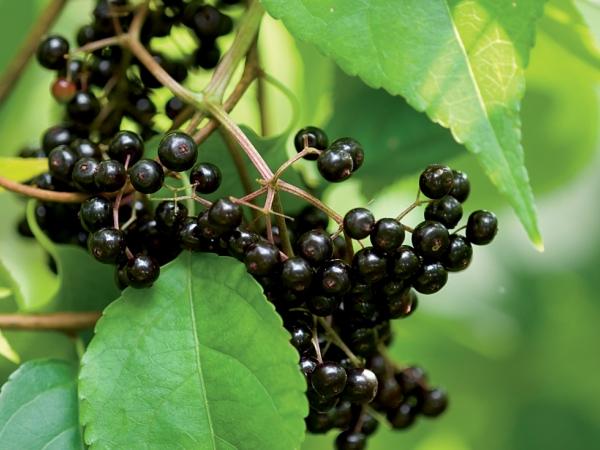
Uses:
Elderberry flowers have been valued as a remedy for colds and fever for centuries; fruit extracts have been shown to have significant antiviral activity, especially against the flu.
Preparation and doses:
Tea: Pour 1 cup boiling water over 1–2 tsp flowers. Steep for 10 minutes. Sweeten if desired and drink hot 2-3 times per day.
Berry extracts: Use as directed.
Concerns:
None known
Garlic (Allium sativum)
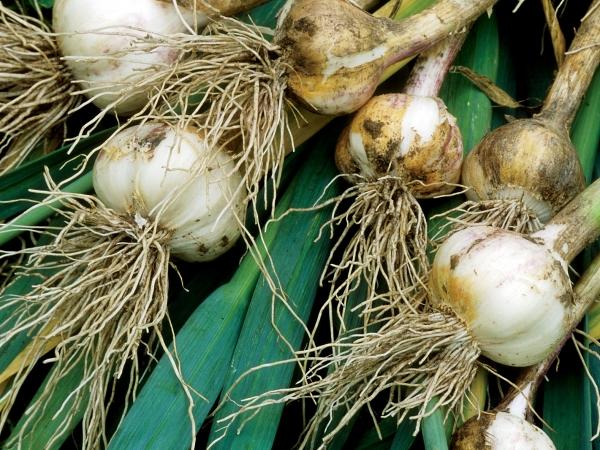
Uses:
Potent antimicrobial; often used to combat colds, ease sinus congestion, and stave off traveler’s diarrhea. Studies show that regular use can help gently lower blood pressure.
Preparation and doses:
Eat: Eat 1–2 cloves fresh daily.
Capsules: Take 4–8 mg allicin per day; enteric-coated products may be superior if specifically treating diarrhea.
Concerns:
May interact with warfarin
Ginger (Zingiber officinale)
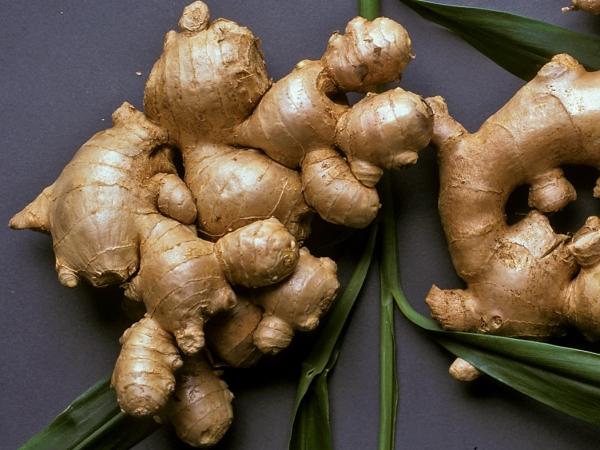
Uses:
Premiere remedy for easing nausea, vomiting, and upset stomach; fresh teas relieve cold and flu symptoms.
Preparation and doses:
Tea: Steep ¼–½ tsp dried ginger or simmer 1 tsp fresh ginger root in 1 cup hot water for 10 minutes. Strain and sweeten, if desired. Drink 1–2 cups per day.
Capsules: Take 250–500 mg 2 times per day.
Concerns:
Very safe in small amounts; heartburn and stomach upset can occur with high doses. Pregnant women should not take more than 1,500 mg per day of dried ginger.
Ginseng (Panax quinquefolius; P. ginseng)
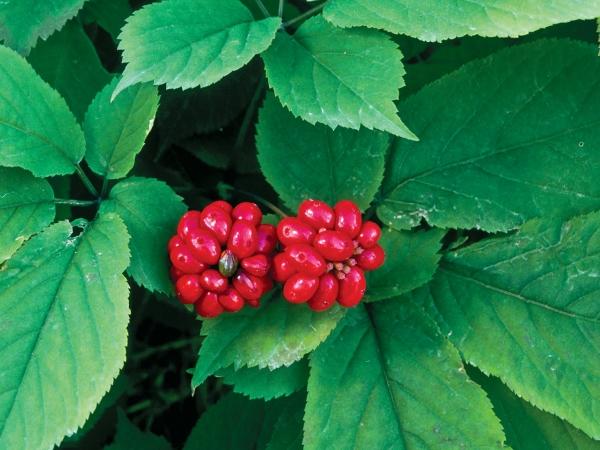
Uses:
Helps relieve and prevent mental and physical fatigue; shown to reduce the frequency and severity of colds; possibly beneficial for erectile dysfunction
Preparation and doses:
Tea: Simmer 1 tsp dried and sliced root in 1 cup water for 10 minutes. Strain. Drink 1–2 cups per day.
Standardized extract (4–7% ginsenosides): 100–400 mg per day
Concerns:
Purchase from a reputable manufacturer, as ginseng has often been adulterated in the past.
Hibiscus (Hibiscus sabdariffa)
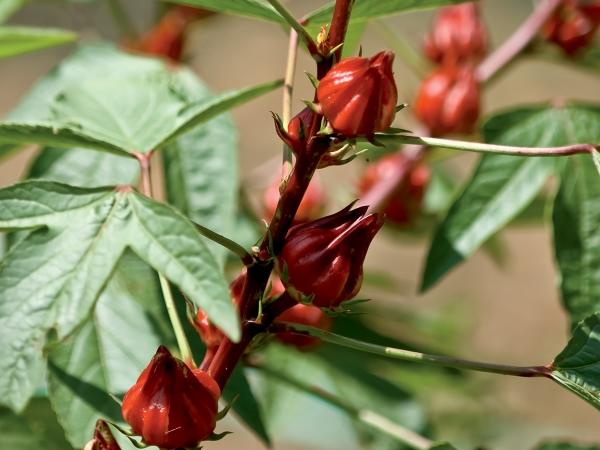
Uses:
Lowers blood pressure and has mild diuretic activity; traditionally used to ease sore throats and colds
Preparation and doses:
Tea: Pour 1 cup boiling water over 1–2 tsp dried flowers. Steep for 10 minutes. Strain and sweeten, if desired. Drink 2 cups per day.
Capsules: Take 1,000 mg 2 times per day.
Concerns:
Talk to your health-care provider if you have high blood pressure.
Hops (Humulus lupulus)
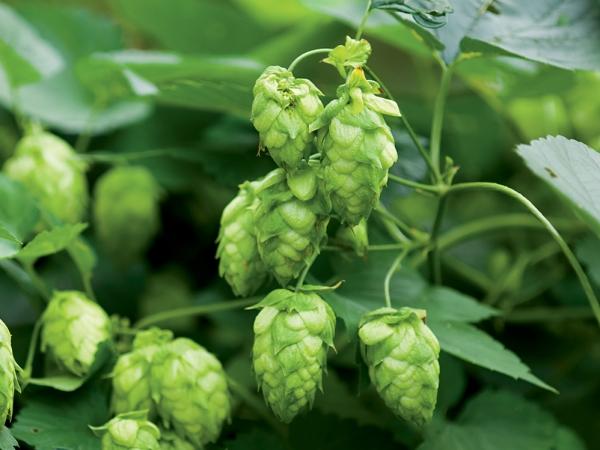
Uses:
Excellent sleeping aid; smaller, daytime doses used to ease tension, restlessness, and anxiety; might help reduce hot flashes during menopause
Preparation and doses:
Capsules: Take 200–300 mg 1-3 times per day.
Tincture: Take 2–4 ml before bed.
Concerns:
Can cause sedation
Horse Chestnut (Aesculus hippocastanum)
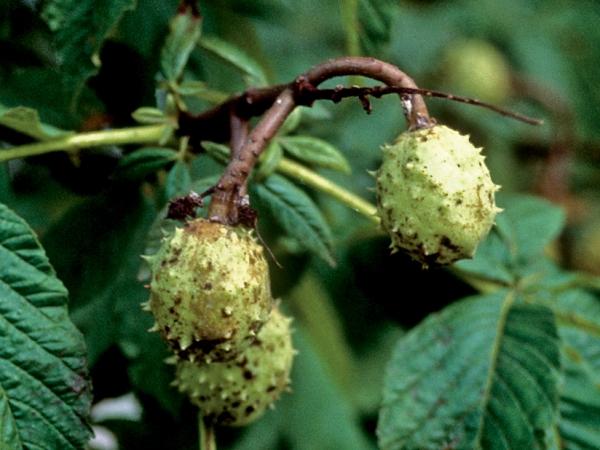
Uses:
Seed extracts shown to be highly effective for treatment of varicose veins and chronic venous insufficiency (blood pools in lower leg veins after standing or sitting); topical gels can reduce swelling and tenderness due to injury.
Preparation and doses:
Seed extract (containing 100–150 mg aescin/escin): Take 600 mg per day in divided doses.
Concerns:
Unprocessed horse chestnut seeds can be toxic; use only appropriately prepared seed extracts.
Kava (Piper methysticum)

Uses:
Clinical trials have shown kava to be highly effective for relieving anxiety. Also has significant muscle-relaxing effects.
Preparation and doses:
Tea: Simmer 1 tsp dried and sliced root in 1 cup water for 10 minutes. Strain. Drink 1–2 cups per day.
Extract of root: Take 100–200 mg 2 or 3 times per day. (Do not exceed 210 mg per day of kavalactones.)
Concerns:
Rare cases of liver toxicity; do not use if you have liver disease, frequently drink alcohol, or are taking acetaminophen or prescription medications.
Lemon Balm (Melissa officinalis)
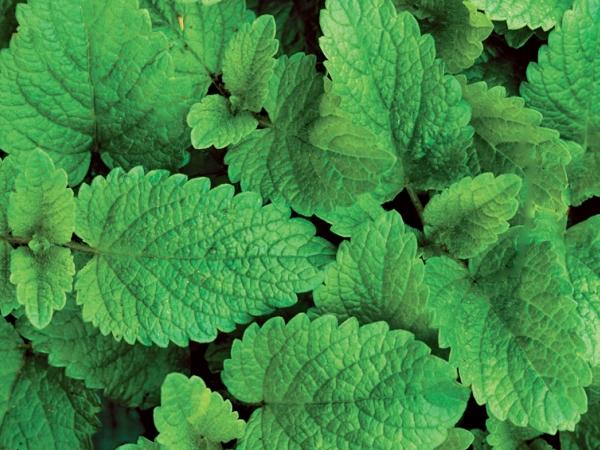
Uses:
Gentle calmative; eases tension, digestive upset, and colic; topical creams used for fever blisters
Preparation and doses:
Tea: Pour 1 cup boiling water over 5 or 6 fresh or 1 tsp dried leaves. Steep for 5 minutes. Strain and sweeten, if desired. Drink several times per day.
Concerns:
None; suitable for all ages
Licorice (Glycyrrhiza glabra)
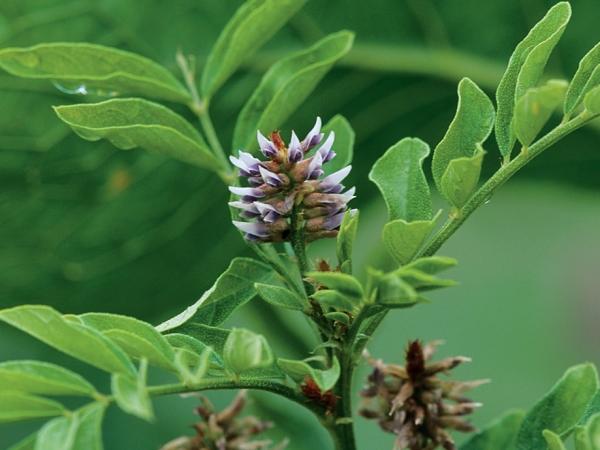
Uses:
Excellent anti-inflammatory; soothes mucous membranes; useful for sore throats and coughs; protects and heals gastrointestinal tract
Preparation and doses:
Tea: Simmer 1 tsp dried and sliced root in 1 cup water for 10 minutes. Strain. Drink 2 or 3 times per day for up to 7 days.
Capsules: Take up to 3,000 mg per day for 7 days. Do not exceed 500 mg per day if taking for longer than 7 days.
Concerns:
Do not use high doses for longer than 1 week as it elevates blood pressure and causes potassium loss. (DGL, a special preparation commonly used for heartburn, is safe for prolonged use.)
Marshmallow (Althaea officinalis)
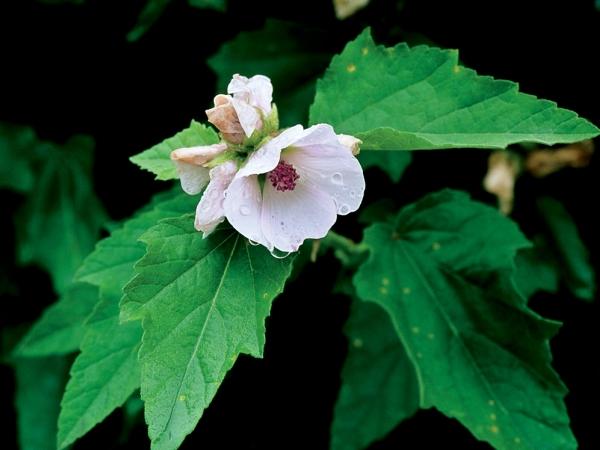
Uses:
Root and leaf are rich in mucilage, a substance that coats the lining of the mouth and throat, as well as the tissue that lines the gastrointestinal tract. Used for sore throat, heartburn, and minor GI inflammation.
Preparation and doses:
Tea: Pour 1 cup hot water over 1 tsp dried and sliced root or 2 tsp leaf. Steep for 2 hours. Strain and drink as desired.
Concerns:
Take other drugs 1 hour prior to or several hours after consuming marshmallow, as it could slow absorption of oral medications.
Milk Thistle (Silybum marianum)
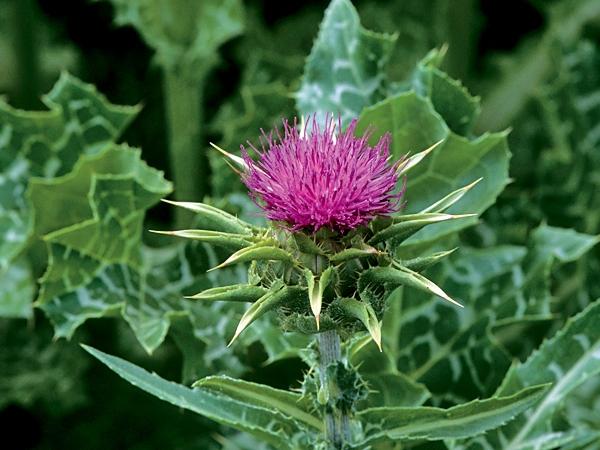
Uses:
Protects the liver from damage caused by environmental toxins, medications, and alcohol. Recent studies suggest it protects the kidneys similarly.
Preparation and doses:
Extract (guaranteed minimum of 70% silymarin): Take 400–700 mg per day in divided doses.
Concerns:
None known
Mullein (Verbascum thapsus)
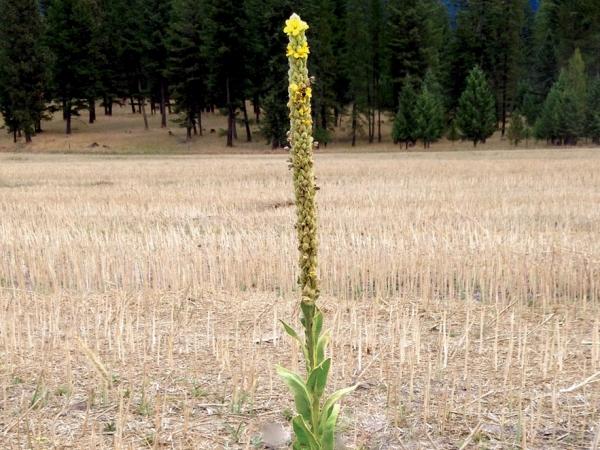
Uses:
Leaves commonly used to relieve cough, sore throat, and chest congestion; steeped in oil, the flowers relieve earache.
Preparation and doses:
Tea: Pour 1 cup boiling water over 1–2 tsp leaves. Steep for 10 minutes. Strain, sweeten, and drink as desired.
Ear oil: Use as directed.
Concerns:
None known
Nettle (Urtica dioica)
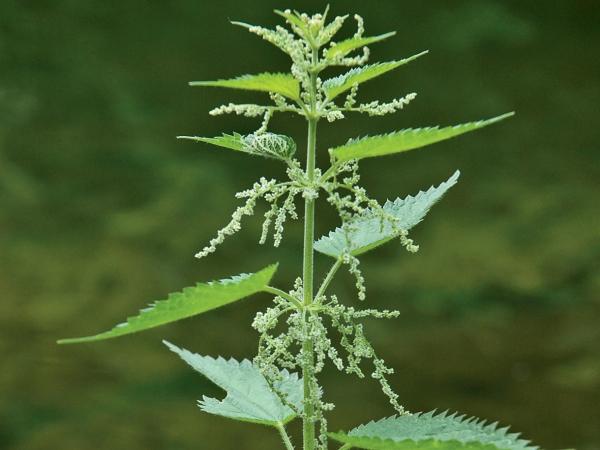
Uses:
Fresh, freeze-dried leaves relieved seasonal allergy symptoms in one human trial. Research supports use of the root for easing symptoms of enlarged prostate. Tea widely recommended for its nutritive value.
Preparation and doses:
Tea: Pour 1 cup boiling water over 2 tsp leaves. Steep for 10 minutes. Strain. Sweeten if desired. Drink 1–3 cups per day.
Freeze-dried nettle capsules: Take 300–500 mg 2 times per day.
Nettle root: Take 250–400 mg 2 or 3 times per day.
Concerns:
Wear gloves when handling fresh nettles to avoid stinging and irritation (sting is lost with cooking or drying); very safe herb.
Sage (Salvia officinalis)
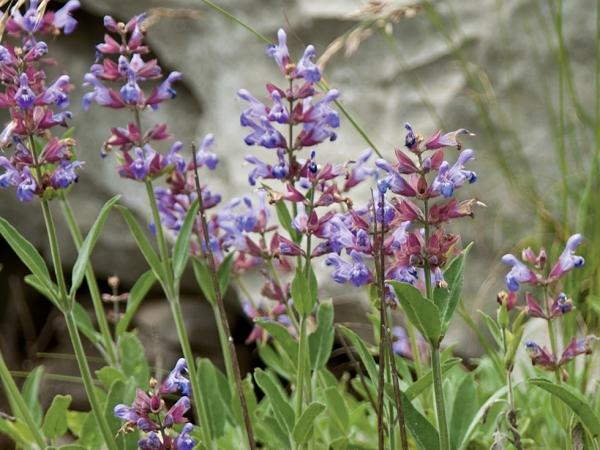
Uses:
Excellent for sore throat, cough, and colds; recognized in Germany as a treatment for excessive sweating; studies show it can help reduce menopausal hot flashes and night sweats.
Preparation and doses:
Tea: Pour 1 cup boiling water over 1 tsp leaves. Steep for 10 minutes. Strain. Drink, or use as a sore throat gargle.
Capsules: Take 500 mg dried leaf 2 times per day.
Concerns:
Do not use therapeutic doses during pregnancy; do not use sage essential oil internally.
Slippery Elm (Ulmus rubra)
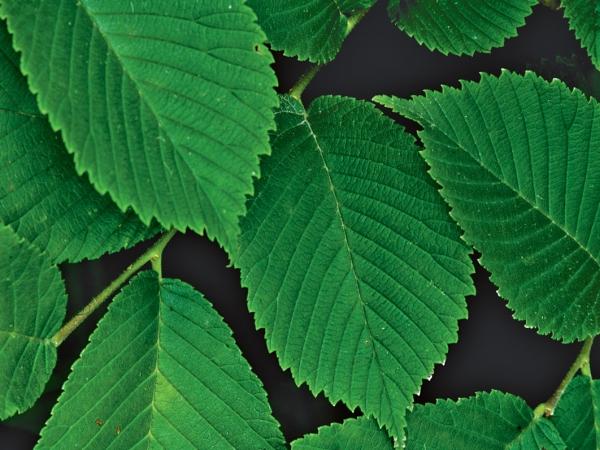
Uses:
FDA-approved as a safe, nonprescription remedy for minor throat irritation; also very useful for relieving cough and occasional heartburn.
Preparation and doses:
Lozenges: Take as directed.
Tea: Pour 1 cup boiling water over 1–2 tsp powdered bark. Steep for 5 minutes. Drink 2 or 3 times per day.
Concerns:
Take other drugs 1 hour before or several hours after consuming, as it could slow absorption of oral medications.
St. John’s Wort (Hypericum perforatum)
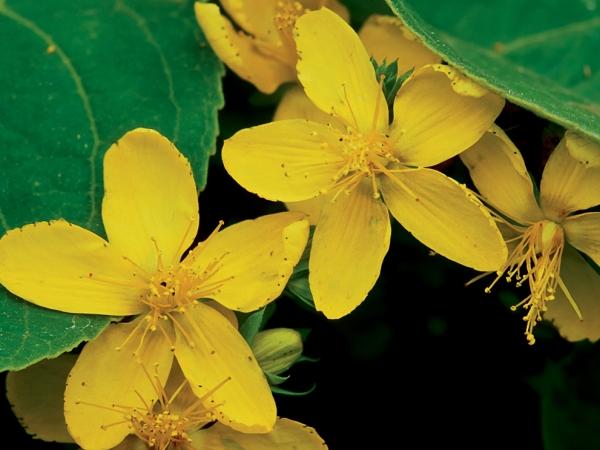
Uses:
More than 40 studies have confirmed its effectiveness for relieving mild to moderate depression; may also relieve PMS symptoms and menopausal hot flashes, especially when combined with black cohosh.
Preparation and doses:
Standardized extract (standardized to 0.3% hypericin and/or 3–5% hyperforin): Take 300–600 mg 3 times per day.
Concerns:
Talk to your physician or pharmacist before using if you are taking prescription medications; the chance for herb-drug interaction is high.
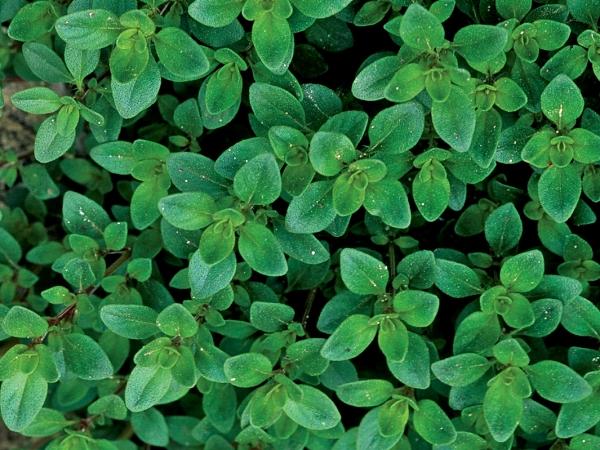
(Thymus vulgaris)
Uses:
Highly regarded for relieving coughs, colds, and congestion; rich in volatile oils that have significant antimicrobial and antispasmodic activity
Preparation and doses:
Tea: Pour 1 cup boiling water over 1 Tbsp fresh or 1 tsp dried leaves. Steep for 10 minutes. Strain and sweeten, if desired. Drink ⅓ cup 3 times per day.
Concerns:
None known
By Tieraona Low Dog, MD – www.prevention.com
Photos Credit: Steven Foster
See Related Articles:
52 Plants In The Wild You Can Eat
21 Plants You Should Never Eat Or Touch
4 Survival Plants That You Didn’t Know Are Edible
Image For Pinterest:
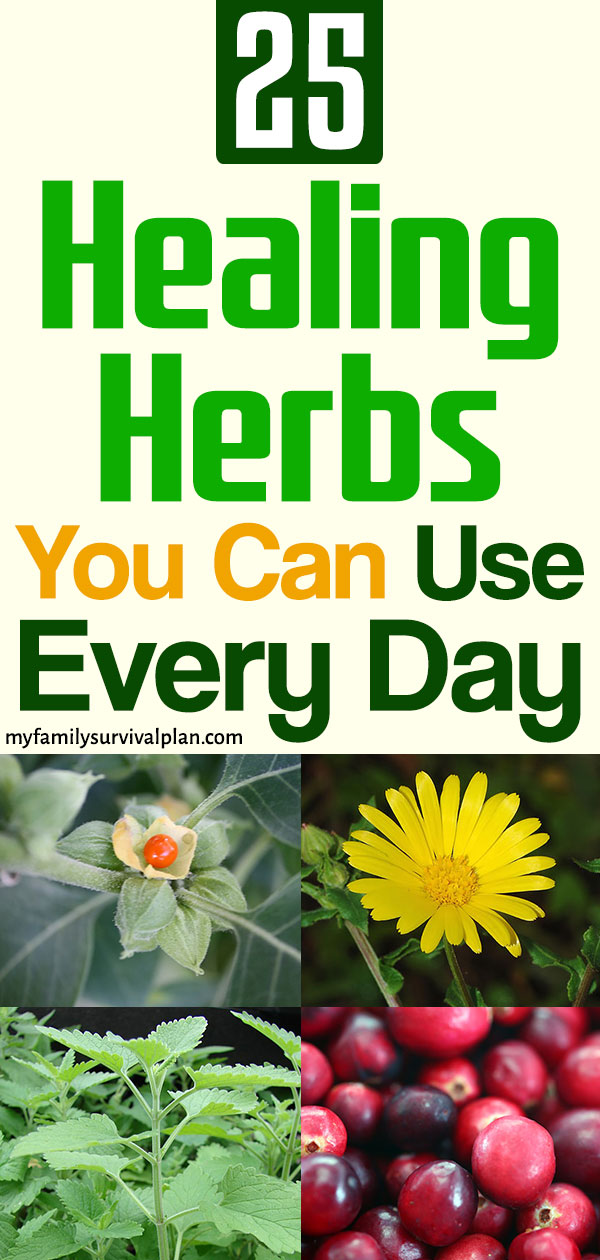
Graphic – www.myfamilysurvivalplan.com
Images – Wikipedia 1 (lic. under CC 3.0), 2 (lic. under CC 3.0), 3 (lic. under CC 3.0), 4 (lic. under CC 3.0)
This Crazy Off Grid Device Literally Makes Drinkable Water From Fresh Air:
According to NASA, the U.S. is expecting a 100-YEAR LONG MEGADROUGHT.
It's already begun. Ask the farmers in California. They know.
Every survivalist knows that water is of critical importance. You NEED an independent water source that you can count on!
As an interesting "survival rehearsal" - imagine that you turned the tap on right now and nothing came out. How long would you last?
But what if there was another water source literally hidden in plain sight. That's right, I'm talking about the atmosphere!
The amazing thing about getting water from the natural moisture in the air... is that it is ALWAYS available.
This gives you real water security!
Learn more about how to tap into "Nature's secret water reservoir" and stay hydrated when TSHTF!
Watch the video:
😳 What Tinnitus Does To Your Brain Cells (And How To Stop It)
After 47 years of studies and countless brain scans done on more than 2,400 tinnitus patients, scientists at the MIT Institute found that in a shocking 96% of cases, tinnitus was actually shrinking their brain cells.
As it turns out, tinnitus and brain health are strongly linked.
Even more interesting: The reason why top army officials are not deaf after decades of hearing machine guns, bombs going off and helicopter noises…
Is because they are using something called "the wire method", a simple protocol inspired by a classified surgery on deaf people from the 1950s...

I Can't Help Showing This Off:
If you haven't heard of Claude Davis yet do yourself a huge favor and watch this video.
One of the smartest guys I ever had the pleasure of meeting, Claude set-up a unique prepping system that changed his life forever.
I already tried it myself and let me tell... you I was completely blown away... His surprising tactics could make your life easier and give you the peace of mind you deserve.
Don't just take my word for it... watch his short video and decide for yourself.

Most People Don't Have The Guts To Try This:
An amazing discovery in an abandoned house in Austin, Texas: A lost book of amazing survival knowledge, believed to have been long vanished to history, has been found in a dusty drawer in the house which belonged to a guy named Claude Davis.
Remember... back in those days, there was no electricity... no refrigerators... no law enforcement... and certainly no grocery store or supermarkets... Some of these exceptional skills are hundreds of years of old and they were learned the hard way by the early pioneers.
>> Click here to find out about them now
We've lost to history so much survival knowledge that we've become clueless compared to what our great grandfathers did or built on a daily basis to sustain their families.
Neighbors said that for the last couple of years Claude has tried to unearth and learn the forgotten ways of our great-grandparents and claimed to have found a secret of gargantuan proportions. A secret that he is about to reveal together with 3 old teachings that will change everything you think you know about preparedness:
>>> Click Here To Watch His Short Video <<<

More Off-Grid And Survival Resources:

What REALLY Happens When You Bury a Shipping Container? (Hint: It's A Bit Crazy...)
Shipping containers are all the rage - but if you are thinking about buying one, you MUST watch this video first:
There's a general belief that if you bury a shipping container you can create an awesome root cellar / storm shelter / survival bunker.
But is a shipping container strong enough to handle the pressure?
Watch the video to see what happens:
What Really Happens When You Bury a Shipping Container? (Click To Watch Video)








